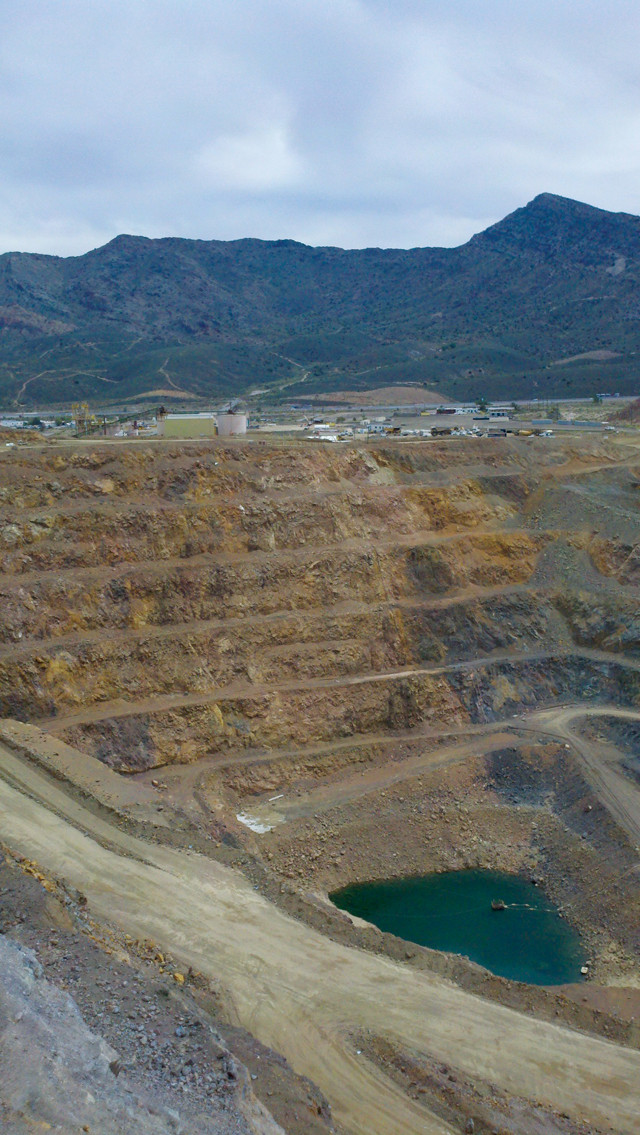
by U.S. Geological Survey Thursday, June 14, 2018
Daniel J. Cordier, rare earth commodity specialist for the U.S. Geological Survey, has prepared the following information on the rare earths, which have been used commercially since the 1880s.

The Sulfide Queen rare earth element mine in Mountain Pass, Calif. The U.S. has not mined rare earth minerals since 2002. Credit: Daniel J. Cordier
The rare earths are a group of 17 metallic elements that occur in nature as nonmetallic compounds. Ironically, they’re not at all rare: As a group, they are about as abundant as lead in Earth’s crust. Rare earths earned their name to distinguish them from the alkaline earth elements (like beryllium, calcium and magnesium) that were found in the same deposits where rare earths were first discovered in Scandinavia in the late 1800s.
The rare earths include scandium, yttrium and the lanthanides. Most are classified into two groups: light rare earth elements (LREE) and heavy rare earth elements (HREE). The lighter group includes the lanthanide elements from atomic number 57 (lanthanum) through atomic number 64 (gadolinium), and the heavy group includes the lanthanide elements from atomic number 65 (terbium) through atomic number 71 (lutetium), along with yttrium. Scandium is not classified as either a light or a heavy rare earth element.
The similar atomic radii and oxidation states of the rare earth elements allow liberal substitution for one another within the crystal lattice sites of minerals, so all 17 typically occur in different percentages in each rare earth mineral. This substitution accounts for their wide dispersion in Earth’s crust and their characteristic occurrence within more than 100 minerals. However, their chemical similarity also makes it difficult and costly to separate them from each other in processing.

Rare earth elements are used in hybrid cars. Credit: Megan Sever
The principal ores of the rare earths are bastnäsite, lateritic (iron- and aluminum-rich) ion-adsorption clays, monazite and xenotime. Xenotime was the principal ore of yttrium until it was replaced by lateritic ion-adsorption clays from southern China in the 1990s. These intensely weathered clays have rare earth ions adsorbed into the clay mineral structure. An interesting silicate mineral that is being developed as a source for HREE and zirconium is eudialyte, which is found in the U.S., Canada, New Zealand, Australia and Russia. Producing rare earths from these diverse sites would cut into China’s near-monopoly on rare earth production today; the country currently produces 97 percent of the world’s rare earths.
Despite China’s large-scale production of rare earths, the elements may be coming into short supply. In 2010, there was no rare earth mine production in the U.S. However, the U.S. has remained a supplier of rare earth compounds processed by Molycorp, Inc. Molycorp last mined and processed bastnäsite in 2002 at its Mountain Pass, Calif., mine, and is planning to reopen its mining facilities in 2012.
Rare earths have hundreds of commercial applications, from metallurgical alloys to automotive catalytic converters to phosphors for computer monitors. They are increasingly used in advanced technology industries, in hybrid cars, and in alternative and renewable energy. There are often no substitutes for rare earths in these applications.
For more information on rare earth elements and other mineral resources, visit: minerals.usgs.gov/minerals.
RARE EARTH PRODUCTION AND CONSUMPTION:
In 2010, world production of rare earths was estimated at 130,000 metric tons of equivalent rare earth oxides.
China is by far the leading producer of rare earths, followed by India, Brazil and Malaysia, with limited rare earth processing in the United States.
FUN FACTS:
ommercial development of rare earths started in Scandinavia with the invention of the incandescent lamp mantle by Auer von Welsbach in 1884.
here are only about 500 grams of promethium — used in fluorescent lights in extremely small quantities — estimated to occur in the world. All commercially used promethium is produced as a fission product from nuclear reactors or by thermal neutron bombardment of neodymium.
adolinium is used as a contrast agent in magnetic resonance imagery (MRI).
eodymium is a principal component of NdFeB permanent rare earth magnets used in the construction of new MRI devices.
utetium is used in the detector for Positron Emission Tomography (PET) scans, a nuclear medical imaging technique for showing damage to the heart.
candium is used primarily in lightweight, high-strength aluminum alloys for sports and camping equipment, including baseball and softball bats, bicycle frames, lacrosse stick handles and tent poles.
uropium, abundant in Mountain Pass, Calif., bastnäsite ore, made possible a true red-color phosphor for color televisions in the 1960s.
RARE EARTHS UNDER THE SEA?
In early July, geologists in Japan reported finding vast amounts of rare earth elements in the Pacific Ocean floor. The concentration of rare earths is high enough that if mined, just one square kilometer of ocean floor could provide up to one-fifth of the world’s annual consumption of rare earth elements, the team found.
Yasuhiro Kato of the University of Tokyo in Japan and his colleagues analyzed more than 2,000 sediment samples collected at 78 sites around the Pacific Ocean. Concentrations were particularly high in seafloor mud just one meter deep in the eastern South and central North Pacific, they reported in Nature Geoscience. The rare earth elements would be easy to recover from the seafloor mud by simple acid leaching, the team found. However, whether the mud is economically recoverable is another question: The samples were collected from the seafloor between 3,500 and 6,000 meters below the ocean surface.
© 2008-2021. All rights reserved. Any copying, redistribution or retransmission of any of the contents of this service without the expressed written permission of the American Geosciences Institute is expressly prohibited. Click here for all copyright requests.